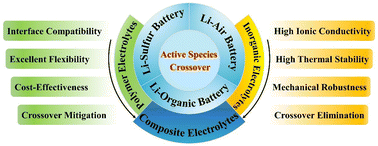Solid-state electrolytes for inhibiting active species crossover in lithium metal batteries: a review
Abstract
Growing concerns about safety incidents and range anxiety in pure electric vehicles powered by lithium-ion batteries have led to increasing interest in solid-state lithium metal batteries. Compared to non-aqueous liquid electrolytes, the use of solid-state electrolytes not only avoids volatility, flammability, and short-circuits, but also inhibits the crossover of active species in various lithium-metal batteries, such as Li–sulfur, Li–organic and Li–air batteries. Among them, active species crossover comprises oxygen crossover, organic molecule diffusion, the shuttle effect of soluble polysulfides and lithiated organics in non-aqueous electrolytes. Although different active species possess diverse physicochemical properties, the challenge of crossover can be effectively addressed with solid-state electrolytes. Based on the above, this review focuses on the application of solid-state electrolytes for handling active species crossover in lithium metal batteries. Moreover, the key factors determining the usability of the method are summarized based on current applications, guiding strategies for inhibiting active species crossover in lithium-metal batteries. Finally, this review offers an insight into future research on practical solid-state lithium metal batteries.

- This article is part of the themed collection: 2023 Materials Chemistry Frontiers Review-type Articles


 Please wait while we load your content...
Please wait while we load your content...